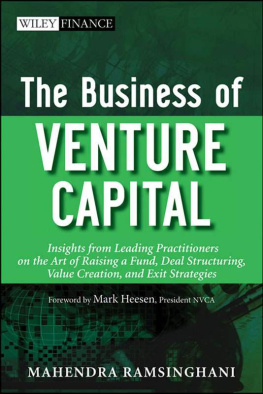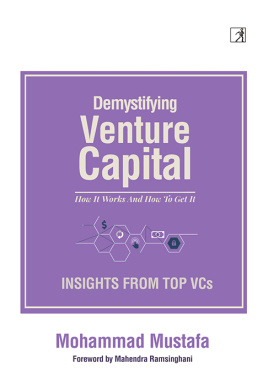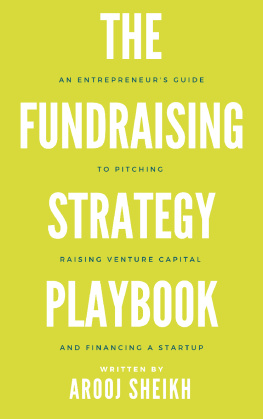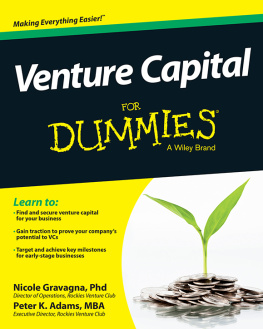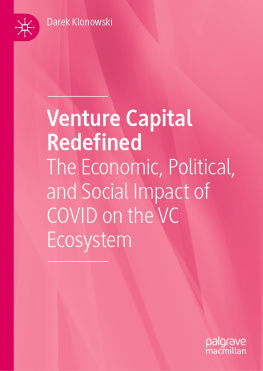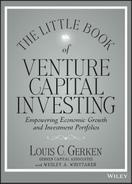Contents
Founded in 1807, John Wiley & Sons is the oldest independent publishing company in the United States. With offices in North America, Europe, Australia and Asia, Wiley is globally committed to developing and marketing print and electronic products and services for our customers professional and personal knowledge and understanding.
The Wiley Finance series contains books written specifically for finance and investment professionals as well as sophisticated individual investors and their financial advisors. Book topics range from portfolio management to e-commerce, risk management, financial engineering, valuation and financial instrument analysis, as well as much more.
For a list of available titles, visit our Web site at www.WileyFinance.com .
Copyright 2011 by John Wiley & Sons, Inc. All rights reserved.
Published by John Wiley & Sons, Inc., Hoboken, New Jersey.
Published simultaneously in Canada.
No part of this publication may be reproduced, stored in a retrieval system, or transmitted in any form or by any means, electronic, mechanical, photocopying, recording, scanning, or otherwise, except as permitted under Section 107 or 108 of the 1976 United States Copyright Act, without either the prior written permission of the Publisher, or authorization through payment of the appropriate per-copy fee to the Copyright Clearance Center, Inc., 222 Rosewood Drive, Danvers, MA 01923, (978) 750-8400, fax (978) 646-8600, or on the Web at www.copyright.com . Requests to the Publisher for permission should be addressed to the Permissions Department, John Wiley & Sons, Inc., 111 River Street, Hoboken, NJ 07030, (201) 748-6011, fax (201) 748-6008, or online at http://www.wiley.com/go/permissions .
Limit of Liability/Disclaimer of Warranty: While the publisher and author have used their best efforts in preparing this book, they make no representations or warranties with respect to the accuracy or completeness of the contents of this book and specifically disclaim any implied warranties of merchantability or fitness for a particular purpose. No warranty may be created or extended by sales representatives or written sales materials. The advice and strategies contained herein may not be suitable for your situation. You should consult with a professional where appropriate. Neither the publisher nor author shall be liable for any loss of profit or any other commercial damages, including but not limited to special, incidental, consequential, or other damages.
For general information on our other products and services or for technical support, please contact our Customer Care Department within the United States at (800) 762-2974, outside the United States at (317) 572-3993 or fax (317) 572-4002.
Wiley also publishes its books in a variety of electronic formats. Some content that appears in print may not be available in electronic books. For more information about Wiley products, visit our web site at www.wiley.com .
Library of Congress Cataloging-in-Publication Data:
Ramsinghani, Mahendra.
The business of venture capital : insights from leading practitioners on the art of raising a fund, deal structuring, value creation, and exit strategies / Mahendra Ramsinghani.
p. cm. (Wiley finance series ; 612)
Includes index.
ISBN 978-0-470-87444-8; ISBN 978-1-118-13038-4 (ebk);
ISBN 978-1-118-13039-1 (ebk); ISBN 978-1-118-13040-7 (ebk)
1. Venture capital. I. Title.
HG4751.R36 2011
332.04154068dc23
2011017545
In the memory of my parents
and
to Deepa and Aria,
the light, the song, and the dance
Foreword
If the business of venture capital is driven by the entrepreneurial forces that cause creative destruction, venture capital is the primary fuel that drives these forces. Armed with this ammunition, entrepreneurs leapfrog toward the new frontiers at a rapid pace. Closely teamed up with these entrepreneurs are venture capital professionals, who bring insights and direction and, at times, act as guardrails for the entrepreneurial energy and enthusiasm. This book, The Business of Venture Capital, whose primary audience is an entry-level venture practitioner, addresses the critical elements of the venture capital investment process: raising the fund, sourcing and structuring investments, creating value as a board member, and, finally, leading investments to exits.
The quest for new frontiers has led to the significant growth of venture capital over the past two decades. I was recruited to lead the National Venture Capital Association (NVCA) in 1991. Since then, the venture capital industry has grown significantly and venture capital is now recognized as an asset class with distinctive merits. In the early nineties, annual venture investments in U.S. companies was $7 billion. Fifteen years later, this has grown threefold to $20+ billion. (Of course, we will ignore the 19992000 era when investments grew to $100 billion.) Tied to this growth is the flow of capitalassets under management, the number of funds, and the number of professionals in the venture business, all of which have grown at an equal pace. Institutional investors are driven by financial returns. Corporate and government entities invest in venture funds to spur technological development and social change.
Christopher Columbus said, Following the light of the sun, we left the old world. After all, it's primal for man to seek new frontiers. While those in earlier times sought to discover unknown lands and bring home spices and gold, modern-day entrepreneurs and adventurers seek to break down the frontiers of technology and business. As we know, venture investments started in the late sixties but the nineties experienced rapid growth and formal structures were established into a norm. The first wave of venture investments grew with the advent of the semiconductor industry, closely followed by the growth computing industry. The mainframe and desktop, software, networking, and the Internet led to the peak of the frenzy in the year 2000 with venture investments reaching $80$100 billion. This frenzy also generated triple-digit returns for venture funds for a brief period, leading to more capital flows into this asset class. However, recent years have created a new set of demands on venture professionals. As the technology wave shifts to mobile computing and social networks, energy and clean-tech sectors have attracted much attention. While these sectors have different return dynamics as compared to the technology era, a steady flow of capital and opportunities is drawing the battle lines for the next wave of creative destruction. Life sciences and health care, sectors that have largely remained steady, have seen a spurt of recent activity. The underlying drivers of cost and insurance premiums combined with aging demographics will sustain the pace of investments. However, in recent years, political drive to reform health care has spurred adoption of technology in areas such as medical records, where venture investments may see growth. Drug discoverythe other end of the life sciences investment spectrumalso continues to see considerable opportunities due to consolidation within the industry and the growing cost of drug development combined with pressures of generics.
On the geographic front, the United States continues to lead the venture activity due to underlying structural advantages of a judicial, taxation, and regulatory environment peppered with innovation and entrepreneurial mind-set. Despite several challenges, the European Union, China, India, Israel, and other countries in the Middle East have experienced growth in venture capital, private equity, and infrastructure investments. Venture professionals know the importance of a supportive government in paving the way for growthbe it through research grants or tax incentives. Several countries are closely following the proven recipe of success that the United States has experienced. The entrepreneurial drive combined with the set of market conditions gives the United States the edge that is not easy to replicate across cultural nuances. For example, the rate of formation of anchor companies (companies that started from scratch and are listed in the 1,000 biggest companies by market capitalization over the past 20 years) in the United States is four times as many as are found in the European Union. In the European Union, entrepreneurs are perceived as exploiters of resources at twice the rate that they are so perceived in the United States. Despite which, successful companies like Skype have generated wealth for venture professionals. Singapore leads governmental reform and investments in technology research parks. Five percent of companies in Singapore are venture backed. Israel leads in entrepreneurial drive and innovation, especially in security and defense, turning the political issues into opportunities. Creating a stable political environment combined with a strong legal infrastructure that speedily addresses corporate, shareholder, taxation, and intellectual property concerns is the foundation on which venture investments can be established. The harder challenge is not government mandates, but social acceptance and change. A government cannot create, but only support, entrepreneurial drive as it's largely a complex interplay of emotional and social dynamics. For instance, while Japan leads the world in filings of intellectual property, the linkages with venture capital and start-up formation have not been visible. The Global Entrepreneurship Monitor (GEM) global report gives Japan the lowest score for entrepreneurship of any large country, largely due to its risk-averse orientation. Bankruptcy in Japan equates largely to being ostracized and in the extreme, leads to suicide. Eventually, some regions will march, some will drift, and some will be dragged into the entrepreneurial domain. And no matter what your zip code is, the basics of the business remain the samethe ability to raise capital, invest it prudently, add value as a board member, and generate exits. The Business of Venture Capital seeks to offer valuable insights to a rookie venture practitioner or a business school student aspiring to pursue a career in venture capital. While parts of the subject have received attention from publishers in the past, this book promises to be the first comprehensive attempt to focus on the four critical elements of the venture capital business. Raising a venture fund calls for a deeper understanding of what investors (Limited Partners) seek in venture funds. The art of sourcing investments is dependent on the team's operating expertise, the fund's past successes, and brand identity. While structuring term investments may appear fairly straightforward, Mahendra Ramsinghani touches on the underlying logic that is embedded in term sheets. And most professionals learn how to be good board members by watching the senior partners at work. This book helps the reader to understand the basics of boardroom behavior and the ways value can be added in the arc of a portfolio company's growth. And while exits occur as acquisitions of public offerings, this book helps with understanding the underlying aspects that lead to the final step in return creation. Mahendra's career progression as a venture practitioner, former limited partner, and entrepreneur encompasses the 360 degrees of venture capital. He has sought insights of leading venture capitalists and compiled their views in this book, which can be a good starting point for any practitioner. These insights combined with experience allow him to structure the contents of this book in a relevant manner. This book not only informs and educates on the process of venture investments, but also balances the glory with the realitythis is a business where only returns matter and time is not your friend! Venture capital is a lifelong apprenticeship. The business of investing requires equal parts logic and intuition; the yin and the yang; the alpha and the omega. As in life, much can be taught by books but most is learned on the battlefield, where a few earn the honors, most become martyrs, and the rest carry the scars for a lifetime.
Next page
